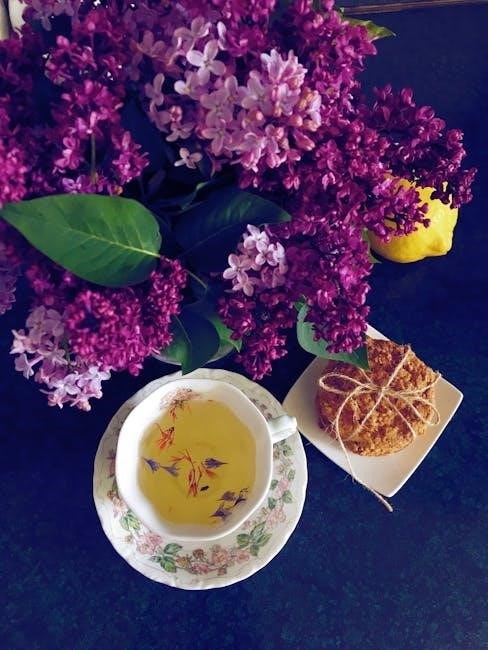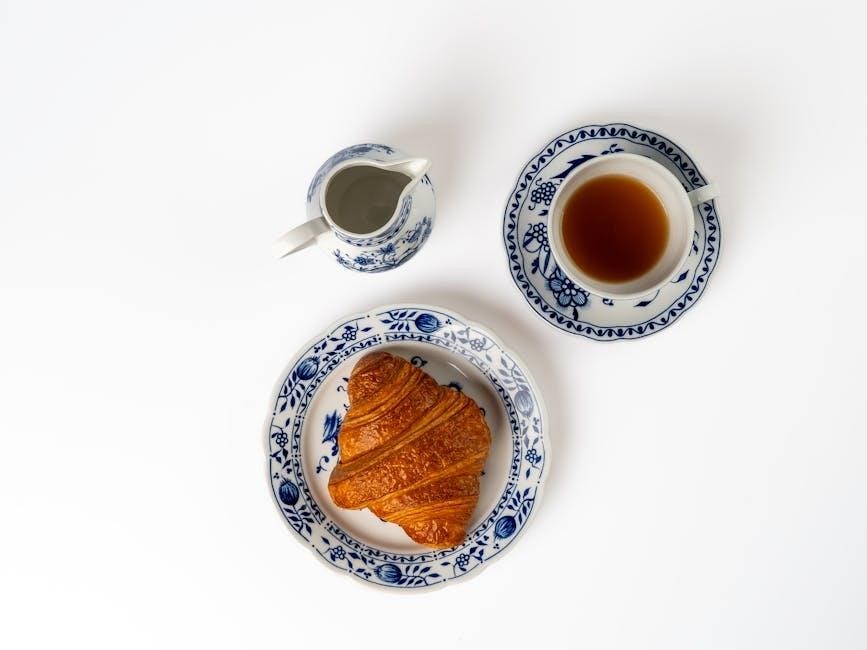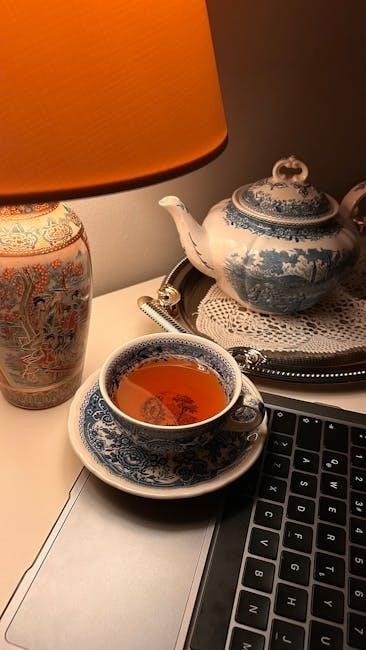
Genuine Essiac Tea is a traditional herbal blend known for its potential health benefits. This guide provides clear instructions for brewing, dosage, and preparation to ensure maximum effectiveness and safety. Proper methods are essential to unlock the tea’s detoxifying and immune-supporting properties, making it a valuable addition to a holistic health routine.
Overview of Essiac Tea
Essiac Tea is a traditional herbal remedy believed to support detoxification and immune health. Originating from Rene Caisse’s recipe, it combines sheep sorrel, burdock root, slippery elm, and turkey rhubarb. The tea is known for its potential to enhance overall well-being. Proper preparation involves boiling the herbs and steeping them to release their active compounds. Regular consumption, typically 2-4 ounces daily, is recommended for optimal benefits. Essiac Tea is a natural health tool that has gained popularity for its simplicity and potential therapeutic properties, making it a popular choice for those seeking alternative wellness solutions.
Importance of Following Proper Instructions
Adhering to proper brewing and preparation guidelines ensures the full potential of Essiac Tea is realized. Incorrect methods can lead to reduced effectiveness or even contamination. Using non-aluminum utensils and high-quality herbs is crucial for safety and potency. The recommended boiling time and temperature help release the herbs’ active compounds. Proper dilution and storage maintain the tea’s integrity, preventing spoilage and ensuring consistent benefits. Following instructions carefully maximizes the tea’s detoxifying and immune-supporting properties, making it a reliable and effective natural health supplement for those seeking holistic wellness.
History and Origins of Essiac Tea
Essiac Tea originates from traditional Canadian folk medicine, popularized by Rene Caisse in the 1920s. Its roots trace back to Indigenous herbal remedies, emphasizing natural healing and holistic wellness.
Rene Caisse and Her Discovery
Rene Caisse, a dedicated Canadian nurse, discovered Essiac Tea in the 1920s. She learned the recipe from a patient who attributed their recovery to this traditional blend. Rene refined the formula and spent her life researching its health benefits, earning recognition for her work. She never patented the tea, ensuring it remained accessible. After her passing, a trusted friend shared the recipe, preserving her legacy. Rene’s commitment to natural healing continues to inspire those seeking holistic health solutions.
Traditional vs. Modern Preparations
Traditionally, Essiac Tea was prepared by boiling herbs in water, then steeping and cooling. Modern methods simplify the process using pre-measured packets, reducing preparation time. While the core ingredients remain the same, contemporary approaches focus on convenience without compromising quality. Some variations include adding extra herbs for enhanced benefits, but the original four-herb blend remains popular. Both methods aim to preserve the tea’s natural properties, ensuring its effectiveness and accessibility for today’s health-conscious individuals.
Ingredients of Genuine Essiac Tea
Genuine Essiac Tea is made from a traditional 4-herb blend: Sheep Sorrel, Burdock Root, Slippery Elm, and Turkey Rhubarb. Organic, high-quality herbs ensure optimal potency and safety.
4-Herb Blend: Sheep Sorrel, Burdock Root, Slippery Elm, and Turkey Rhubarb
Genuine Essiac Tea is crafted from a precise blend of four organic herbs: Sheep Sorrel, Burdock Root, Slippery Elm, and Turkey Rhubarb. Sheep Sorrel contributes detoxifying properties, while Burdock Root supports immune function. Slippery Elm aids digestion, and Turkey Rhubarb enhances cleansing. This balanced combination, as discovered by Rene Caisse, ensures the tea’s therapeutic potential. Each herb plays a vital role, making high-quality, organic sourcing essential for optimal benefits.
Importance of Organic and High-Quality Herbs
Using organic, high-quality herbs is crucial for Genuine Essiac Tea’s effectiveness. Organic sourcing ensures the herbs are free from pesticides, heavy metals, and other contaminants, maximizing their therapeutic potential. Rene Caisse emphasized the importance of purity and potency in the herbs to achieve optimal health benefits. High-quality ingredients guarantee the tea’s detoxifying, immune-supporting, and anti-inflammatory properties are fully realized, making it essential to source from reputable suppliers to maintain authenticity and efficacy.

Brewing Instructions for Essiac Tea
Brewing Essiac Tea involves boiling water, adding herbs, simmering, and steeping. Use non-aluminum utensils and follow precise steps to ensure potency and safety. Proper preparation enhances benefits.
Gathering Supplies: Water, Herbs, and Equipment
To prepare genuine Essiac Tea, you’ll need 4.5 quarts of distilled or purified water, 1 pound of the 4-herb blend, and a large stainless steel or glass pot with a lid. Avoid aluminum or Teflon utensils, as they can react with the herbs. A strainer or cheesecloth is also necessary for filtering. Ensure all equipment is sterilized before use to maintain cleanliness. Store the herbs in an airtight container to preserve freshness. Some suppliers offer pre-measured packets for convenience, simplifying the preparation process. Gather all supplies beforehand to streamline the brewing process.
Step-by-Step Brewing Process: Boiling, Steeping, and Cooling
Begin by boiling 4.5 quarts of distilled water in a stainless steel or glass pot. Add 1 pound of the Essiac herb blend, stirring gently. Boil for 10 minutes, then reduce heat to a simmer and let steep for an additional 10 minutes. Remove from heat and allow the mixture to cool slightly. Strain the tea into a clean container using cheesecloth or a fine-mesh strainer. Discard the solids and let the tea cool to room temperature. Transfer to glass bottles and refrigerate for later use. This process ensures optimal extraction of the herbs’ benefits.
Optimal Brewing Time and Temperature
The ideal brewing time for Essiac Tea is 10 minutes at a medium boil, followed by a 10-minute steeping period off the heat. This ensures the herbs release their full potential without becoming bitter. The recommended temperature is between 195°F and 205°F for boiling, then allowing it to cool slightly before steeping. Proper timing and temperature are crucial for maximizing the tea’s detoxifying and immune-supporting properties. After cooling, the tea should be at room temperature before refrigeration to preserve its potency and ensure safety for consumption.
Importance of Using Non-Aluminum Utensils
Using non-aluminum utensils is crucial when preparing Essiac Tea to prevent chemical reactions that could compromise its efficacy and safety. Aluminum can react with the herbs, potentially leading to the release of harmful substances. Stainless steel, glass, or enameled cookware is recommended to ensure the tea remains free from contaminants. This precaution safeguards the tea’s quality and maintains its health-promoting properties, ensuring a safe and effective brewing process.
Dosage Guidelines for Essiac Tea
Recommended daily intake is 2-4 ounces, taken once or twice on an empty stomach. Maximum dosage is 4 ounces per day for optimal benefits and safety.
Recommended Daily Intake: 2-4 Ounces
The suggested daily consumption of Essiac Tea is 2-4 ounces, divided into one or two servings. For optimal benefits, take it on an empty stomach, ideally in the morning or evening. This dosage supports detoxification and immune function without overwhelming the system. Rene Caisse’s original formula recommends not exceeding 4 ounces per day to maintain balance and effectiveness. Adjustments can be made based on individual sensitivity, ensuring the tea is consumed in a way that promotes overall well-being and hydration.
Best Time to Consume: On an Empty Stomach
For optimal absorption, Essiac Tea is best consumed on an empty stomach, either in the morning before breakfast or at least 30 minutes before meals. This allows the body to fully utilize the herbal properties without interference from food. Avoid eating for 30 minutes after consumption to ensure the tea is not diluted. Ideal times include early morning or before bedtime, as it supports detoxification and immune support during rest. Consistency in timing enhances the tea’s effectiveness and promotes overall well-being.
Frequency: Once or Twice Daily
For optimal results, Essiac Tea is typically consumed once or twice daily. A maintenance serving size of 3 ounces, divided into two doses, is recommended for consistency. Drinking the tea once daily is sufficient for some, while others prefer twice daily for enhanced benefits. Start with a lower frequency to assess tolerance, then gradually increase as needed. Consistency is key to experiencing the tea’s detoxifying and immune-supporting effects. Adjust frequency based on personal health goals and sensitivity to the herbal blend.
Maximum Recommended Dosage: 4 Ounces Per Day
The maximum recommended dosage of Essiac Tea is 4 ounces per day, as advised by Rene Caisse. Exceeding this amount is unnecessary and may lead to discomfort. While the tea is not toxic, consuming more than 4 ounces daily could cause mild stomach upset or reduce its effectiveness. Stick to the suggested dosage to ensure safety and optimal benefits. Adjustments should only be made based on personal tolerance or specific health needs, always prioritizing moderation for the best experience.

Health Benefits of Essiac Tea
Essiac Tea is renowned for its detoxifying properties, immune support, and anti-inflammatory effects. It promotes overall well-being, aids digestion, and is a natural source of hydration.
Detoxification and Immune Support
Essiac Tea is highly regarded for its detoxifying properties, aiding the body in eliminating harmful toxins. The 4-herb blend, particularly sheep sorrel and burdock root, supports the liver and kidneys, enhancing natural cleansing processes. Additionally, the tea boosts the immune system by providing essential nutrients and antioxidants, helping to combat infections and maintain overall health. Regular consumption may improve energy levels and promote a balanced digestive system, further supporting immune function and detoxification efforts.
Anti-Inflammatory Properties
Essiac Tea is renowned for its anti-inflammatory properties, which can help alleviate conditions like arthritis and digestive disorders. The herbal blend, particularly slippery elm and turkey rhubarb, contains compounds that soothe inflammation in the body. Regular consumption may reduce swelling and discomfort, promoting healing and overall well-being. These properties make Essiac Tea a natural remedy for managing chronic inflammation and supporting long-term health. By addressing inflammation at its source, the tea contributes to a balanced and healthy lifestyle.
Hydration and Digestive Health
Essiac Tea is an excellent source of hydration, supporting the body’s essential functions like temperature regulation and waste elimination. Its high water content makes it comparable to drinking water, ensuring proper bodily functions. Additionally, the tea aids digestive health by soothing the gastrointestinal tract, thanks to ingredients like slippery elm. This natural remedy helps maintain a healthy digestive system, preventing issues like bloating and indigestion. Regular consumption can enhance overall hydration levels and promote a balanced digestive system, contributing to improved well-being and energy levels. It’s a simple yet effective way to support daily health needs.

Preparation Tips for Essiac Tea
Essiac Tea is easy to prepare and versatile in serving. It can be enjoyed hot, cold, or warm, making it suitable for any time of day.
Storing the Tea: Refrigeration and Shelf Life
Genuine Essiac Tea should be stored in the refrigerator to maintain its potency and freshness. Use a glass container with a tight-fitting lid, avoiding aluminum. The tea will typically keep for up to eight days when refrigerated. For optimal quality, consume within this period. Keep the tea away from direct sunlight and heat sources. Proper storage ensures the tea’s detoxifying and immune-supporting properties remain intact, providing the best health benefits. Always check for any signs of spoilage before consumption, such as an off smell or mold, to ensure safety.
Reheating and Serving Options: Hot, Cold, or Warm
Genuine Essiac Tea can be enjoyed hot, cold, or warm, offering flexibility in consumption. For reheating, gently warm the tea over low heat without boiling to preserve its herbal properties. Some prefer adding lemon or honey for flavor, though it’s best consumed naturally to maintain its integrity. Avoid using microwaves, as they may degrade the tea’s potency. Whether you choose to sip it steaming, chilled, or at room temperature, Essiac Tea remains a refreshing and health-promoting beverage option. This versatility makes it easy to incorporate into daily routines for optimal wellness.

Storage and Handling of Essiac Tea
Store Essiac Tea in airtight glass containers in a cool, dark place or refrigerate to maintain freshness. Avoid exposure to moisture and light for optimal preservation.
Proper Storage Containers and Conditions
Use airtight glass containers to store Essiac Tea, ensuring the lid is tightly sealed. Keep in a cool, dark place away from direct sunlight and moisture. Avoid storing in aluminum or plastic containers to prevent chemical reactions. The ideal storage temperature is between 50°F and 70°F (10°C to 21°C). If refrigerated, the tea can last for up to two weeks. Always check for signs of spoilage before consumption, such as an off smell or mold. Proper storage preserves the tea’s potency and maintains its health benefits.
Shelf Life and Stability of the Tea
Genuine Essiac Tea maintains its stability when stored properly, typically lasting up to six months if unopened and kept in a cool, dark environment. Once prepared, refrigerated tea should be consumed within two weeks to prevent degradation. Always check for spoilage signs before consumption. The tea’s potency and benefits remain intact under these conditions, ensuring optimal effectiveness when used as directed. Proper storage is key to preserving the tea’s quality and health-enhancing properties.

Comparisons and Alternatives to Essiac Tea
Essiac Tea is often compared to Flor-Essence, another herbal blend. While both share similar health-promoting properties, Essiac remains distinct for its traditional roots and simple formulation, making it a preferred choice for many seeking natural wellness solutions.
Flor-Essence and Other Herbal Blends
Flor-Essence is a popular alternative to Essiac Tea, offering a similar detoxifying and immune-supporting profile. It contains eight herbs, including the four in Essiac, with added ingredients like red clover and burdock root. While Essiac is prized for its simplicity and traditional roots, Flor-Essence is often preferred for its broader herbal spectrum. Other blends, like Traditional Medicinals or Yogi Tea, also exist but differ in formulation and purpose. Each alternative may suit different health needs, making it important to choose based on personal preferences and wellness goals.
Modern Variations of the Original Recipe
Modern variations of Essiac Tea often include additional herbs or organic enhancements to boost potency. Some blends incorporate superfoods or adaptogens to tailor the tea for specific health needs. These variations may differ in taste and preparation but aim to maintain the original’s therapeutic benefits. While some brands stick to Rene Caisse’s traditional four-herb formula, others innovate to appeal to diverse preferences. These adaptations ensure Essiac remains relevant in today’s health-conscious market, offering choices for those seeking enhanced or specialized herbal experiences. Always opt for high-quality, organic ingredients to preserve the tea’s integrity.
Troubleshooting Common Issues
Address bitter taste by diluting with water or adjusting steeping time. For sediment, use a fine-mesh strainer or let tea settle before serving. Ensure proper storage to maintain flavor and potency.
Addressing Bitter Taste or Sediment
If the tea tastes bitter, dilute it with more water or reduce steeping time. Sediment can be minimized by using a fine strainer or letting it settle before serving. For sensitivity, start with a smaller dose and gradually increase. Adjustments ensure a pleasant experience without compromising benefits.
Adjusting Dosage for Sensitivity
For individuals with sensitivity, start with a smaller dose (1-2 oz) and gradually increase as tolerance allows. If discomfort occurs, reduce the amount or frequency. Some users find benefit in alternating days or consulting a healthcare provider for personalized advice. Always prioritize hydration and monitor body reactions to ensure a comfortable experience while maximizing potential benefits.
Genuine Essiac Tea is a simple yet potent herbal remedy offering detoxification, immune support, and digestive health benefits. Follow proper brewing and dosage guidelines for optimal results.
Final Thoughts on Preparing and Consuming Essiac Tea
Preparing and consuming Genuine Essiac Tea is a straightforward process when following proper guidelines. Ensuring the use of high-quality, organic herbs and non-aluminum utensils is crucial for safety and effectiveness. Storing the tea in a cool, dark place and consuming it on an empty stomach maximizes its benefits. Consistency in dosage and brewing methods is key to experiencing the tea’s detoxifying, anti-inflammatory, and immune-supporting properties. By adhering to these instructions, individuals can fully harness the potential of Essiac Tea as part of a holistic health routine.